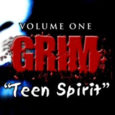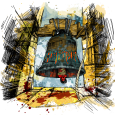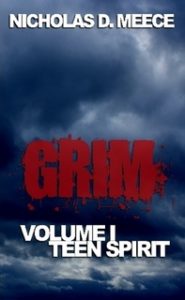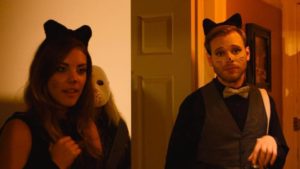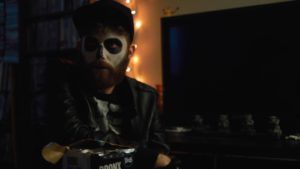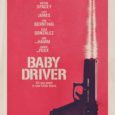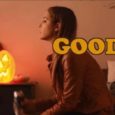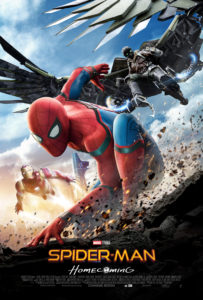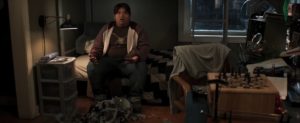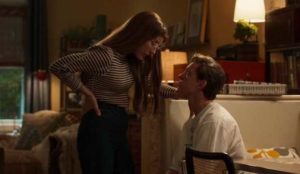March 26, 2014 was a sad day in television as it marked the final episode of Psych on USA Network. Millions of fans across the country thought that was the last they’d see of Shawn Spencer and Burton Guster, the duo responsible for the titular psychic detective agency. Little did we Psych-Os know the showrunners had another trick up their sleeve: a movie. Airing on December 7th, Psych: The Movie reunites the bulk of the main cast and I, for one, couldn’t be more excited.
In preparation of the movie, I sat down and revisited all 8 seasons of Psych, which was no easy task since the show was removed from Netflix and I had to watch everything on DVD. Can you imagine swapping out all those discs as each episode ended? It was exhausting.
Anyway, here are my picks for the top 15 episodes of Psych. Wait for iiiiiiit…
—————————————————————————————————————————–
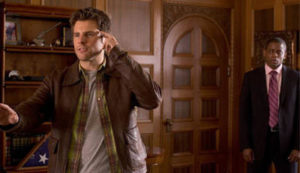 Pilot
Pilot
Season 1, Episode 1
Pilot episodes usually aren’t the best episodes of any series; it often takes time for the characters’ personalities to gel and worm their ways into our hearts. But in the case of Psych, the characters are pretty much as they are fresh off the page. Shawn Spencer (James Roday) is lazy and unambitious despite his gift of hyper-perception and deductive reasoning. He uses this gift to call in numerous tips to the police in an effort to collect reward money but when the cops start to suspect him as the culprit, his only out is to feign psychic powers. Though he’s met with some skepticism, courtesy of Santa Barbara head detective Carlton Lassiter (Tim Omundson), he convinces the interim police chief Karen Vick (Kirsten Nelson) to bring him on a case. At that point, Shawn drags his best friend and enabler Burton “Gus” Guster (Dulé Hill) along for the ride. We also get a look at Shawn’s strained relationship with his father, Henry (Corbin Bernsen), an ex-cop who is not too happy with Shawn lying to the cops, but when he goes to bat for Shawn and reveals what he’s willing to do for his kid.
—————————————————————————————————————————–
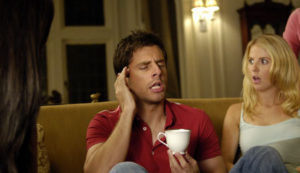 Scary Sherry: Bianca’s Toast
Scary Sherry: Bianca’s Toast
Season 1, Episode 15
When a sorority hazing goes badly and ends with the death of a college girl, the incident is written off as a copycat suicide based on the death of Santa Barbara’s urban legend, Scary Sherry. Juliet (Maggie Lawson), however, goes undercover in the sorority to investigate deeper, asking Shawn and Gus for help. “Scary Sherry: Bianca’s Toast” doesn’t feature any big name guest stars or off-beat musical improv but the teacup scene is one of the funniest moments in the show and I’m including it on this list for that alone. Also, the B-plot with Lassiter training an elder rookie has some great moments.
—————————————————————————————————————————–
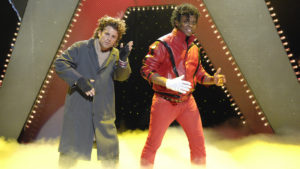 American Duos
American Duos
Season 2, Episode 1
When a judge on the hit singing competition reality show “American Duos” has a few brushes with death, he goes to the Santa Barbara police for protection. A parody of Simon Cowell, Nigel St. Nigel is portrayed to perfection by a smug Tim Curry and his performance carries the episode. Bonus points for the second special guest star, Gina Gershon, playing a booze-riddled and absent-minded former pop star, a clear lampooning of Paula Abdul. Bonus bonus points for the episode also giving us James Roday and Dulé Hill dressed as Roland Orzabal and Michael Jackson while performing Tears for Fears’ “Shout.”
—————————————————————————————————————————–
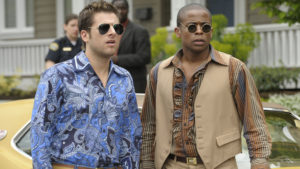 Disco Didn’t Die. It Was Murdered!
Disco Didn’t Die. It Was Murdered!
Season 3, Episode 5
“It’s a big birthday cake!” Taking its influence from the pop culture of the 70s, including shows like The Mod Squad and movies like Shaft, Shawn and Gus are called in to find new evidence in a case that was recently overturned, which just so happened to be the biggest case of Henry Spencer’s career. The trio need to track down clues which brings smack dab into the middle of the 70s; from the polyester shirts to a ’73 Mercury Cougar to a 70’s-themed disco run by a dude named “Pookie,” “Disco Didn’t Die” hits all the notes to fan the flames of nostalgia in the most humorous way possible.
—————————————————————————————————————————–
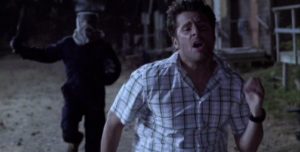 Tuesday The 17th
Tuesday The 17th
Season 3, Episode 15
Written and directed by James Roday, “Tuesday the 17th” is the first episode that takes film homage to the next level by taking influence from classic horror movies. When an old camp friend approach Shawn and Gus to investigate the disappearance of a counselor at his new camp, they soon find themselves being stalked by a masked slasher. But the swerve, that the camp is meant to be a murder mystery camp where people figure out the identity of the killer, is met with another swerve, wherein a real killer is picking off the counselors one by one. The episode features almost every horror movie trope known to man and, in general, has a ton of fun with the premise.
—————————————————————————————————————————–
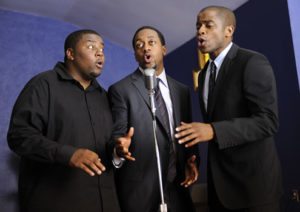 High Top Fade-Out
High Top Fade-Out
Season 4, Episode 7
There are a lot of things to point to as making “High Top Fade-Out” a great episode. It features guest appearances by Jaleel White and Kenan Thompson as old college friends of Gus, as well as 50% of Gus’s college singing group, Blackapella. Tony Todd also makes an appearance though slightly less Candyman and more undercover cop. The episode marks the introduction of Kurt Fuller as coroner Woodrow Strode, a character that would make multiple appearances through the series and become more off the wall each time. The intro song was rerecorded by Boyz II Men as a way to cement the singing quartet theme. But probably my favorite part of the episode is Dulé Hill’s performance. Though he’s never been a slouch in any episode, he emotes a full range from anger to pain to concern as he works to repair his relationship with his friends. Every minute of it is fantastic.
—————————————————————————————————————————–
 Mr. Yin Presents…
Mr. Yin Presents…
Season 4, Episode 16
The second episode in the Yang trilogy, “Mr. Yin Presents…” is a love letter to Alfred Hitchcock. The murder of a waitress leads Psych and the police to discover that Yang was working with a partner, the mysterious Mr. Yin. After Shawn fingers Mary Lightly (Jimmi Simpson) as the killer, he realizes how wrong he is when Mary winds up dead, murdered in the same manner as Detective Arbogast from the Hitchcock film Psycho. The gang soon find themselves in a trap, each playing a role from different Hitchcock movies; Shawn as L.B. Jefferies from Rear Window, Henry as Mark Rutland from Marnie, etc. The episode is filled with references to Hitchcock, both visual and in dialogue. It’s a fantastic watch and leads to some great character development for the rest of the series.
—————————————————————————————————————————–
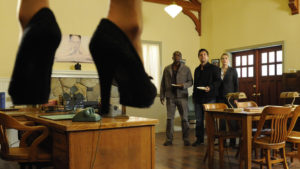 Dual Spires
Dual Spires
Season 5, Episode 12
Despite the recent revival, Twin Peaks was one of those cult shows that had a rabid fan base but never really struck a chord with the culture at large. The showrunners of Psych however, found enough to work with and centered an entire episode around its atmosphere. Featuring many of the original stars of Peaks, “Dual Spires” plops Shawn and Gus in the center of a small mountain town where the people are a little off-beat, forcing them to dig through the residents’ idiosyncrasies to discover the truth behind the murder of a young woman. Dana Ashbrook, Ray Wise, and Sherilyn Fenn all make appearances, as well as Chris Isaak’s “Baby Did a Bad Bad Thing” in a nod to the 1992 Twin Peaks movie, Fire Walk With Me.
—————————————————————————————————————————–
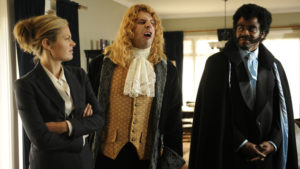 This Episode Sucks
This Episode Sucks
Season 6, Episode 3
Don’t let the title fool you; the episode is actually pretty good. Admittedly, I almost didn’t put it in but the more I thought on it, the better it became. This is the vampire episode and the showrunners went all in making that apparent. The episode not only guest stars Kristy Swanson and Corey Feldman, both vampire famous in their own right, but Tom Lenk show ups, who had a recurring role in the Buffy TV series. “This Episode Sucks” essentially benches Shawn and Gus, relegating them to second fiddle as they freak out over the idea of vampires in Santa Barbara (though they do dress up as famous vampires; Shawn as Lestat and Gus as Blacula). Despite all of that, I like this episode as it gives Lassie a chance to shine. It introduces Marlowe as his love interest which sets up his character arc for the remainder of the series. Shawn and Gus may be the protagonists of the show but it’s nice when some of the other characters get the spotlight.
—————————————————————————————————————————–
 Lassie Jerky
Lassie Jerky
Season 7, Episode 3
There’s no denying the impact found footage films have had on the movie industry. Luckily, the writers of Psych recognized this and blessed us with their own take on the genre. Wrapped around the search for Bigfoot, “Lassie Jerky” finds Shawn and Gus in the woods with some college film students when they stumble upon three dead bodies. The episode is a masterpiece shot from all first-person perspectives and perfectly homages the classic found-footage film, The Blair Witch Project. It also guest stars WWE’s Big Show and has probably my favorite scene in the entire series, an impromptu acapella rendition of the Bangles’ “Eternal Flame.”
—————————————————————————————————————————–
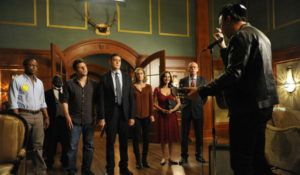 100 Clues
100 Clues
Season 7, Episode 5
The landmark 100th episode of the series. Shawn gets himself invited to a dinner party in a swanky mansion and tries to smooth his relationship woes with Juliet. When she can’t make it, he brings Gus along and discovers that the party was thrown by a recently released from jail rock icon, Billy Lipps, with all of the party guests tied to the case that sent him to prison. A riff on the movie Clue, “100 Clues” was promoted with a real-time contest that allowed viewers to choose who the killer of the episode really was by using a special hashtag on Twitter. Much of the humor in the episode is based on Clue and also includes three of the film’s stars as guest stars: Leslie Ann Warren, Martin Mull, and Christopher Lloyd.
—————————————————————————————————————————–
 Psych: The Musical
Psych: The Musical
Season 7, Episodes 15 & 16
This might be cheating a bit as it spans two episodes but “Psych: The Musical” originally aired as a 2-hour special so suck it, I’m counting it. Though I’m not a fan of musicals, I wholly enjoyed this episode, if only because of how they made each of the musical interludes diegetic. Shawn and Gus are tasked with tracking down an escaped mental patient, a deranged writer who learns that a version of his play based on the Jack the Ripper murders, is premiering at the local playhouse. There are a number of highpoints in the episode, including the return of Ally Sheedy in her role as Yang, Anthony Rapp, best known for as Mark in Rent, and Dulé Hill as “Jamaican Inspector Man.”
—————————————————————————————————————————–
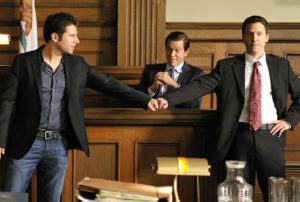 Remake A.K.A. Cloudy…With a Chance of Improvement
Remake A.K.A. Cloudy…With a Chance of Improvement
Season 8, Episode 3
One of the more off-beat episodes of the entire series sees the gang remaking an episode from the first season as a commentary on Hollywood’s remake culture. “Cloudy…With a Chance of Murder” focused on a school teacher who was charged with the murder of the local weatherman, with Shawn and Gus assisting her legal team in getting her acquitted. “Remake” follows that same premise but peppers it by recasting the guest stars, many of whom had already appeared in other episodes as completely different characters. Thankfully, they also saw fit to change the murderer and the method behind the murder, so as to deliver an almost new mystery. My favorite part, though, was the appearance of Ed Lover as the court bailiff and his delivery of the classic “come on, son” line.
—————————————————————————————————————————–
 Nightmare on State Street
Nightmare on State Street
Season 8, Episode 9
I really seem to like the episodes that homage classic horror movies, huh? Anyway, “Nightmare on State Street” has a lot going for it, most notably guest star Bruce Campbell. The film focuses on Gus’s nightmares, which stem from Shawn’s absence and leads directly into the end of the series. As such, the episode devotes significant time to A Nightmare on Elm Street, and more than just the title. But the episode also references Night of the Living Dead and Texas Chainsaw Massacre, all while framed within Gus’s dreams. Other guest stars round out the fun, such as Dean Cameron, who played Chainsaw in one of Shawn’s favorites, Summer School, William Zabka, a.k.a. Johnny Lawrence from Karate Kid, and Phylicia Rashad, who returns as Gus’s mother. “Nightmare on State Street” aims for horror lovers and hits the mark with its numerous references. Oh, and zombie Curt Smith.
—————————————————————————————————————————–
 The Break-Up
The Break-Up
Season 8, Episode 10
I really needed to add the series finale here, mostly because of how well it ties up each characters’ arc. Shawn has a difficult time telling Gus that he’s moving to San Francisco to be with Juliet, especially after Gus manages to find a new job and get his life back on track. This episode shows the depths of Shawn and Gus’s relationship, with Shawn blaming himself for disrupting Gus’s life but Gus uprooting himself to be with his best friend. It also gives us closure to Lassie’s respect for Shawn when he refuses to listen to Shawn’s video confessional that he’s not a real psychic despite years of Lassie’s skepticism. We also get to see McNab finally promoted, assuming the title of detective despite having the worst score Lassie has ever seen. All of this is wrapped up alongside guest appearances by two actors idolized by Shawn; Billy Zane and Val Kilmer. “The Break-Up” is an emotional finish to a hilarious train ride and, in my opinion, the perfect way to end the series.
—————————————————————————————————————————–
Boom boom boom… Wrap up! I know a lot of my fellow Psych-Os out there may disagree with a few of my choices, which is fair. Narrowing down a list like that has been one of the hardest things to do, especially with a show as diverse as Psych has been through the years. So hey, if you disagree with me, let me know! What is your favorite episode? And what are you most excited for from the upcoming movie? Feel free to drop a comment down below or you can find me on Twitter, @IdiotAtPlay, and tweet me your picks.
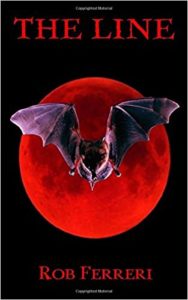 Vampires are a staple of Halloween and one of the most famous horror icons around. So I figured reading a vampire tale for Hallow-Reads was as good an idea as any. That’s when I was presented with The Line by Rob Ferreri, a self-published novel about a team of vampire hunters.
Vampires are a staple of Halloween and one of the most famous horror icons around. So I figured reading a vampire tale for Hallow-Reads was as good an idea as any. That’s when I was presented with The Line by Rob Ferreri, a self-published novel about a team of vampire hunters.
The Line tells the story of Alexander, an immortal ex-vampire and his mission to hide an ancient amulet from Dorian, his ex-master. When the amulet is discovered in present day New York, Alexander assembles a team to help him combat the vampire threat and protect the amulet. The team, which he dubs “the Line” are chosen ones, people who come from a long line of vampire slayers. The plot boils down to Buffy the Vampire Slayer meets The Avengers and works in many ways. However, there are quite a few ways that it just falls flat.
The book opens with a scene of our Alexander being healed of his vampirism and turning against his former brethren. It’s an interesting concept, one that doesn’t get explored often in pop culture, but it also doesn’t get explored much here, either. We know Alexander had a history as a vampire and worked with Dorian, but Ferreri never delves into that. There’s no back story showing us how Alexander became a vampire or what regrets he may have. We’re only told he was a vampire, isn’t any more, and now wants to rid the world of vampires.
The dialogue tags were the most tedious part of the book. Dialogue tags should be straightforward as the most effective ones are a simple “she said” or “he asked.” Sure, it’s great to mix them up a bit for some exclaiming, questioning, or accusing. But The Line makes them all as homogenous as possible. Every dialogue tag follows all of the dialogue. Every time. Now, this isn’t how most authors handle it; in scenes with two characters, for example, it’s generally easy to follow the flow of the dialogue, making the need for a tag each time unnecessary. But Ferreri uses them for every line and it gets very distracting.
From my understanding, The Line was originally written as a screenplay, and after reading it, that’s fairly obvious. The dialogue tags, for example, reminded me of slugs, the character name that precedes each line of dialogue, making it easy for the actor to know which lines are theirs and which belong to their costars. Sure, Ferreri punches up his dialogue with adverbs, but these are little more than parentheticals, the stage direction used to indicate how the actor should deliver the line.
This isn’t the only similarity The Line as a novel has to a screenplay. The book focuses a lot on the action; every few pages, a new action scene occurs. Whether it’s a showdown between the protagonists and the bad guys or some sort of training exercise, action scenes take precedence. Which makes sense considering The Line is a vampire based action adventure more than anything else. However, this focus detracts from any sort of character development, of which there is very little.
The Line is straight forward, to the point, and exactly what one could expect from a ninety minute action flick.
Does a novel need chapters of deep backstory to be enjoyable? No, not at all, but unlike movies, novels aren’t constrained by a certain length. There’s no hard and fast rule that a novel should be a set number of pages. In that sense, novels have an advantage over films when it comes to character development.
The Line implements a sort of ticking clock, yet another action movie trope. Alexander and Co must stop Dorian from getting the other half of the artifact before the next lunar eclipse or the world will suffer. Because of this, the plot moves at hyperspeed. Characters are introduced, destinies explained, trainings held, and lots of fight. There’s no time to get to know the cast. We see them put through the wringers of training a total of one time before they accept their fate. They trust each other implicitly after knowing each other for at most a couple of days. There’s very little internal conflict and it gets resolved in a page or two, which diminishes the stakes.
The parallel between The Line as a novel versus a screenplay makes sense when you look at author Rob Ferreri’s history. He’s worked on a few full-length feature films, most of which were made prior to the publication of The Line. He clearly has a strong grasp of writing, but it seems that scripting is a difficult habit to shake. Novels and screenplays are two different creatures and what works in one doesn’t necessarily work in the other. I don’t feel that his writing style is bad; just that it’s not the ideal approach for a novel.
Don’t get me wrong; there are quite a few good parts about The Line, most notably the character introductions. When we meet each of the characters, they get the spotlight in their own little vignette of a story. Detective Jay Hong is ambushed during one of the biggest cases of his career. The Blades brothers, Diego and Julian, are career criminals and we first see them during a high-octane car theft and eventual chase. Lena Somnianti is a sophisticated artist and fencer, a well-travelled and intelligent woman. They all make grand entrances, yet don’t really live up to their promise. Sure, they’re competent enough in their own right but none of them ever feel fleshed out besides what we learn at the outset.
This is really the fatal flaw of The Line. It never really lives up to its own story. It’s complete, has a plot and a diverse cast, but that’s the bare minimum when dealing with a novel. As a film, The Line would have been magnificent fun. More Underworld than Anne Rice, it didn’t quite fit into my idea of “horror” so it probably wasn’t the best entry for Hallow-Reads, but I still found myself engrossed in the tale as it unfolded.
The Line is available on Amazon. You can also see more of Ferreri’s work by visiting his comic publisher, Evil Kat Comix.
Grade: C
Don’t forget to try our Ten Family Friendly Halloween Movies to help lull the kiddos into a candy coma! Afterward, you can set the mood with Five Albums to Flesh Out Your Halloween Playlist and huddle under the covers with Netflix and Chilling – Halloween Movie Edition. Any other off-beat Halloween suggestions to throw our way? You can let us know on Twitter @SubCultured or come party like its 1599 in our Discord server!
Halloween is one of my favorite holidays. Besides all of the cute decorations, cooler weather and delicious special edition food and candy, it’s also the time to plant oneself in front of the television and binge watch scary movies. But what does one do when movies get boring? Turning to books is usually a good idea. Thankfully there’s a subset of writers who focus on telling spooky, scary, or downright grisly tales that are best enjoyed during Halloween. I had the chance to check out one of these tales, Grim, Volume I: Teen Spirit, by Nicholas Meece.
Teen Spirit starts with a grisly murder outside of a nightclub in a small town before transitioning to the story of Steve, a teenager and budding writer, and his best friend, Jen. They share a passion for filmmaking and horror movies, so when Steve tells Jen about the murder and convinces her to investigate it with him, she’s all in. The murders don’t stop there, though, as the Reaper, as he’s known, tears through the town, killing people very close to Steve’s and Jen’s houses.
While I enjoyed Teen Spirit, I do have to say it’s full of missed potential. There are a lot of great moments in it, such as the opening prologue with the murder, which sets the tone for the horror-themed story. However, once our main characters are introduced, a lot just seems to get lost along the way. We meet Steve and find his passion for writing leads him to lock himself in his bedroom for hours on end to finish a work in progress. He’s secretive about his hobby, not allowing anyone to read his stories until he feels they are perfect. He’s in love with his best friend Jen and wants their relationship to blossom into more than just friendship, but they also plan on moving to California and living together, which is slightly weird but at least makes some sort of sense.
Steve gets the most depth while, unfortunately, Jen is more of a one-note character. We know she’s interested in filmmaking and wants to move to California. She likes Steve’s company but doesn’t see him romantically like he sees her. That is, until she’s told that she does see him romantically by a mutual friend. It’s an odd exchange and one that doesn’t really feel natural. In fact, most of the women in the book come off as caricatures, more like plot devices than real women. The exchanges between Jen and her friend Angela feel forced and stilted. There are so few of them that they’re easy to overlook, but the book is so short that these exchanges are huge chunks of the word count.
I thought the story started to pick up around the time Steve convinces Jen to investigate the murder with him. This could have made for an interesting tale and was the thread that I was most looking forward to; two teenagers struggling to use second hand knowledge of police procedurals and figure out who committed a grisly murder would have made for an intriguing tale. Couple that with the twist ending and Steve’s true agenda could have made it even more engaging. It soon becomes apparent, though, that their sleuthing isn’t the purpose of the tale. Meece is taking his love for horror movies and creating a slasher story. However, with a little fleshing out, he could have blended the two genres and created something with a little more meat on the bone.
That’s not to say Teen Spirit isn’t entertaining. It’s just heavily bogged down in horror movie tropes. A couple of fresh out of school kids in their sexual prime. An alcohol-fueled house party that swells out of control. The caring, housewife who’s concerned for the wellbeing of her taciturn son. The inclusion of all of these seem intentional based on Meece’s love of horror. After reading through Teen Spirit, I didn’t quite make this connection and the tropes bothered me. However, I dwelled on the story for a few days before starting writing this and I developed a deeper appreciation for it.
It’s hard for me to go into depth for a review of Teen Spirit only because of how short the story is. I read it entirely in a single train ride of only about an hour, which isn’t a lot of time for a “book.” That’s why my biggest disappointment with Teen Spirit is its length. As I mentioned earlier, there were plenty of areas that Meece could have elaborated on the story, delving deeper into character histories and motivations and actually following through with Steve and Jen’s intentions of tracking the killer. I assume he didn’t do this because he intended to write a short and sweet slasher tale which, if that is the case, he at least succeeded in doing. One benefit Teen Spirit does have is its cliffhanger ending, hinting at a much larger story looming in the distance. As of the time I’m writing this, there has not been a release of Grim, Volume 2, which is slightly disappointing. Hopefully, that’s still on Meece’s “To Do” list and hasn’t been abandoned completely.
All in all, I would recommend Grim, Volume I: Teen Spirit if you’re bored with horror movies on Netflix and are just looking for a change of pace. While it’s not as deep as a Stephen King novel, it provides a quick dose of horror-fueled entertainment. Not too long to get boring, but just long enough to create a creepy, slasher atmosphere. And if you crave more, you can always check out Meece’s non-fiction and movie reviews over at www.morbidmuch.com. He’s definitely a proponent of horror and a voice that adds to the genre.
Grade: B-
Don’t forget to try our Ten Family Friendly Halloween Movies to help lull the kiddos into a candy coma! Afterward, you can set the mood with Five Albums to Flesh Out Your Halloween Playlist and huddle under the covers with Netflix and Chilling – Halloween Movie Edition. Any other off-beat Halloween suggestions to throw our way? You can let us know on Twitter @SubCultured or come party like its 1599 in our Discord server!
Well, it’s finally October, the season of cooler weather, colorful trees and pumpkin spice. It’s also the time to watch scary movies in the lead up to Halloween, and there’s no shortage of choices when it comes to horror. But with all of the Freddys and Jasons and Sammi Currs out there, is there room in a Halloween movie marathon for a film that doesn’t contain buckets of blood? If Good Day is any indication, the answer to that is “yes.”
I first got the chance to see Good Day at the Kew Gardens Festival of Cinema in Queens, NY. I was invited to the screening by the movie’s director, Louie Cortes, and felt compelled to check it out. I’d only seen the trailer for the film and really didn’t know too much about it before I went in. What I saw, however, was much different than I imagined.
Written by Christine Clark and Cortes, Good Day follows the lives of six twenty-somethings in New York City. Much like Pulp Fiction and 2 Days In the Valley, their paths intersect in some meaningful way as they all converge on the same Halloween party. Unlike Pulp Fiction and 2 Days In the Valley, Good Day is a wholesome yet funny look at the gamut of emotions they’re struggling with. Depression, loneliness, loss of a family member, and the fear of a stagnating career. All of these themes are relatable to the audience, which makes the characters feel like real people. They express their emotions and feelings, sometimes in overly verbose ways, but at the end of it, viewers can easily understand their plight.
The film does all of this in a highly engaging and hilarious way. This was probably the most surprising thing about the movie because there isn’t the slightest hint of comedy in the trailer. Watching that, I assumed Good Day was a coming of age melodrama that happened to be set around Halloween. To be fair, though, that trailer was cut well as it didn’t set any expectations for the humor and may have worked in its favor as Good Day was recently nominated for “Best Comedy Feature” at the Alternative Film Festival.
Though the film didn’t win “Best Comedy,” it did walk away with the award for “Best Cast,” which was most deserved. The cast was one of the finer parts of the film. Though Good Day featured no big name stars, most everyone has a great on-screen presence, despite the one or two stilted performances,
The film focuses on Sam M, played by Christopher Poultney. Sam has a strong self confidence which borderlines on arrogance and is forced to reevaluate himself after he meets a girl who doesn’t reciprocate the interest he feels. His storyline comes to a head when he meets Lisa (Kaelin Birkenhead). Lisa displays a hardened exterior to the world despite having a very caring heart. The audience learns this early in the film when Lisa is shaken to hear that her grandfather, whom she’d never had a relationship with, had died.
The film is rounded out with other great characters, such as Lydia, played by Samantha Quintana, a small-town girl who moved to New York for the right reasons but with the wrong motivation and is struggling to find her place. Then there’s Matt (Michael Ryan Assip), Sam’s best friend who dreams of becoming the next great horror movie writer a la George Romero but lacks the focus to finish a screenplay. Though his performance was rocky at first, Matt quickly became one of my favorite characters in the movie, helped along by Assip’s great comedic timing.
Good Day is not a perfect film, however. It is plagued by a number of technical issues, most notably the sound in some areas. A few of the shots feel cramped and claustrophobic, which is likely due to the indie nature of the movie and the need to shoot in any place that feels authentic regardless of size. These things are easy to overlook, though, through the director’s deft cinematography. Cortes has a way of framing his shots that’s simple yet intriguing and makes the movie fun to watch.
As of writing this, Good Day has yet to find a distributor, meaning that it’s unlikely to get a wide release, either in theaters or streaming. There is some good news, though. If you are local to New York, Good Day will be screened for free on October 23rd at the Queen’s Court in Astoria. The film will be shown alongside two surprise short films. The event is BYOB and candy will be supplied so if you’re interested, be sure to check out their Facebook page for more info.
Overall, Good Day is a poignant look at the real issues young people face and the ways in which they cope. It’s the kind of movie that can easily fit into an annual Halloween screening, a welcome break from the horror films and slasher flicks that most people watch every October. Hopefully Good Day will find a distribution deal soon so more people can enjoy it. Given its newly found status as an award winning film, the chances of that seem higher.
Grade: B+
Not looking for something so adult? Try our Ten Family Friendly Halloween Movies to help lull the kiddos into a candy coma! Afterward, you can set the mood with Five Albums to Flesh Out Your Halloween Playlist and huddle under the covers with Netflix and Chilling – Halloween Movie Edition. Any other off-beat Halloween suggestions to throw our way? You can let us know on Twitter @SubCultured or come party like its 1599 in our Discord server!
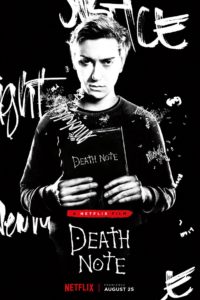 On Friday, Netflix dropped Death Note, a live-action film adaptation of the popular manga/anime of the same name. Since I was free for most of Sunday afternoon, with no plans besides counting down the hours until the seventh season finale of Game of Thrones, I figured I may as well check it out. After all, it was something I was looking forward to, despite the valid whitewashing criticism.
On Friday, Netflix dropped Death Note, a live-action film adaptation of the popular manga/anime of the same name. Since I was free for most of Sunday afternoon, with no plans besides counting down the hours until the seventh season finale of Game of Thrones, I figured I may as well check it out. After all, it was something I was looking forward to, despite the valid whitewashing criticism.
Before you read through my review, please keep in mind, I haven’t read the manga version of Death Note, nor watched a single episode of the anime series. I’m merely critiquing the Netflix movie on its own merits.
Also, while I’m not going to outright give away the ending, I do make references to certain plot points of the film, which may be spoilers for anyone who hasn’t seen it yet. So proceed with caution.
Death Note focuses on Light Turner, a smart high school kid who doesn’t seem to have any friends. His mother was recently killed, leaving just him and his cop father, a dynamic which causes a rift in their relationship. His mother’s killer walked away from the charges and Light doesn’t feel his father pursued the killer hard enough. One day, during a freak storm, Light finds a notebook, the Death Note, which grants the user the ability to kill anyone whose name is written on its pages. There are a bunch of rules associated with the Death Note but it all boils down to “killer notebook.”
Along with his girlfriend Mia, Light (I can’t believe this is the kid’s name) goes on a killing spree. They target bad guys and people who hurt others in an effort to “better the world.” In the process of their murders, they attribute the killings to a karma god of sorts, whom they name Kira, as a way to strike terror into the hearts of evil-doers.
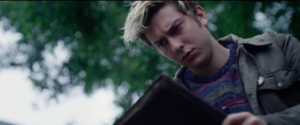 The murders attract the attention of L, an eccentric detective who is fueled by candy and often forgets to sleep. Being a sugar addict seems like an odd character trait to give a prominent character so I assume that this was a carry-over from the source material, but it really seems out of place. The film tried to explain it with an off-hand remark about the “insulin rush” but the trait doesn’t seem natural. In a long form narrative, like the manga or the anime, a quirk like this can developed and also used as a detriment to the character, such as when he’s in a situation lacking sugar. The movie, however, just shoehorns it in with very little (if any) explanation, so it comes off as silly.
The murders attract the attention of L, an eccentric detective who is fueled by candy and often forgets to sleep. Being a sugar addict seems like an odd character trait to give a prominent character so I assume that this was a carry-over from the source material, but it really seems out of place. The film tried to explain it with an off-hand remark about the “insulin rush” but the trait doesn’t seem natural. In a long form narrative, like the manga or the anime, a quirk like this can developed and also used as a detriment to the character, such as when he’s in a situation lacking sugar. The movie, however, just shoehorns it in with very little (if any) explanation, so it comes off as silly.
Then there’s Mia, Light’s girlfriend. She’s the guiding force in Light’s usage of the Death Note, a girl with a dark side that she hides from the rest of the world… except the movie makes the audience aware that she is the “bad girl” from the minute we first see her. She’s smoking a cigarette at cheerleading practice, for example, so clearly she’s edgy. The problem is that Mia has no depth. We never get a glimpse at her past, or at her home life to really understand why she’s so messed up. She is 100% gung-ho about using the Death Note, to the point of threatening Light’s life to convince him to give it to her but it’s never clear why. She’s deeply disturbed and would make for a fascinating character study, but unfortunately she’s used as a side note, only meant to push Light further and further to see how far he’ll go.
My main problem with the film is how easily all of the characters accept the idea of the supernatural being involved in the murders. Light’s cop father wastes no time coming to the conclusion that his son is Kira despite the physical impossibility for him to be so. Even L, with all his grand detective skills, fingers Light early on as the culprit, assuming he has some sort of latent telepathic abilities that allow him to control and kill people.
This wouldn’t be a big deal if the movie established itself as part of a world where this sort of this was commonplace. A few references to some of L’s past cases that document criminals with telepathy or whatnot would go a long way here. From everything we’re shown, however, the viewer has to assume that the film takes place in our world where the laws of physics apply. Yes, Light has a magic book that can kill people but that’s the outlier, not the natural order. If L had been shown to be chasing this book for a decade and realized that it found its way into Light’s hands, his deductions would make sense. But L, from what we’re shown, doesn’t know about the book’s existence and still manages to guess almost every rule. It’s implausible and makes the movie hokey.
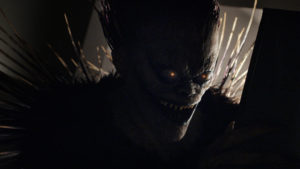 I also had a really difficult time figuring out who I should be rooting for. We get why Light has a hard time with life: his mother is killed, her killer buys himself out of a prison sentence, and he has to deal with bullies at school. So when he gets the Death Note and he’s able to turn everything around, his first act is to kill a classmate. It’s a little out there and doesn’t do much to establish himself as a “good guy.” When it comes to L, the guy who is trying to find justice and stop these murders, we never really connect with him. He is so quirky and abstract that it’s hard to find common ground, so despite his intentions, we don’t really care if he wins or not. It isn’t until he suffers a major loss do we see him exhibit any kind of emotion, and by then it’s too late into the film for the audience to really connect with the character.
I also had a really difficult time figuring out who I should be rooting for. We get why Light has a hard time with life: his mother is killed, her killer buys himself out of a prison sentence, and he has to deal with bullies at school. So when he gets the Death Note and he’s able to turn everything around, his first act is to kill a classmate. It’s a little out there and doesn’t do much to establish himself as a “good guy.” When it comes to L, the guy who is trying to find justice and stop these murders, we never really connect with him. He is so quirky and abstract that it’s hard to find common ground, so despite his intentions, we don’t really care if he wins or not. It isn’t until he suffers a major loss do we see him exhibit any kind of emotion, and by then it’s too late into the film for the audience to really connect with the character.
So who do we root for? The down-on-his-luck killer or the eccentric detective?
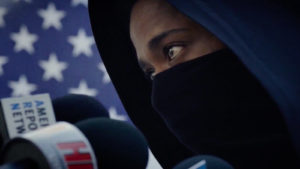 Death Note was directed by Adam Wingard, who is best known for V/H/S and for surprising everyone in 2016 with a new Blair Witch movie. I like Wingard as a director but he seemed to miss the mark with Death Note. The movie is remarkably directed and looks fantastic but really suffers from all of the logical and character inconsistencies in the script. I feel like there was definitely the possibility of a good movie, especially given the depth of the source material, but lacked the proper execution.
Death Note was directed by Adam Wingard, who is best known for V/H/S and for surprising everyone in 2016 with a new Blair Witch movie. I like Wingard as a director but he seemed to miss the mark with Death Note. The movie is remarkably directed and looks fantastic but really suffers from all of the logical and character inconsistencies in the script. I feel like there was definitely the possibility of a good movie, especially given the depth of the source material, but lacked the proper execution.
The cast did a great job with what they were given. Nat Wolff, who played Light, really felt like a lost, angry child, mad at the world for everything that happened to him. Wolff brought a lot of energy and emotion to the role and makes the character likeable despite the terrible things he does. Juxtaposed with that, Lakeith Stanfield as L made a great foil. His delivery as the stoic, brilliant detective drew that divide between the character and the audience, which made it so effective when the character hit his emotional breaking point. As a viewer, I felt his sadness and his rage, and enjoyed the way this emotion mirrored Light’s own, making them two sides of the same coin, of sorts.
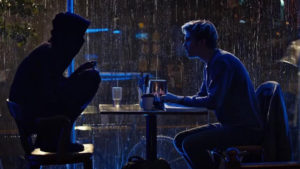 Even Margaret Qualley was fantastic as Mia. Though the character has the least depth of the cast, she’s a driving force to the story. Qualley plays the role with a certain coolness, almost emotionless. It makes the audience wonder if our opinion of the character is wrong or if she truly is a sociopath. Which is a great take considering how little backstory we get of the character.
Even Margaret Qualley was fantastic as Mia. Though the character has the least depth of the cast, she’s a driving force to the story. Qualley plays the role with a certain coolness, almost emotionless. It makes the audience wonder if our opinion of the character is wrong or if she truly is a sociopath. Which is a great take considering how little backstory we get of the character.
One of the highlights of Death Note, though, was Willem Dafoe as the voice of the demon Ryuk. Dafoe never shows up on screen but he brings life, ironically, to the death demon. His performance is reminiscent of his take on the Green Goblin in 2000’s Spider-Man, which I liked. He added a lot to a character that spends most of the movie shrouded in shadows and gives the audience something to grasp.
A Death Note film like this was a huge undertaking, considering it needed to boil down 37 episodes of the source anime into a 100 minute feature. Despite its missteps, the cast and crew did the best they could, unfortunately that didn’t make for a wholly great finished project. It’s the kind of movie to watch on a lazy weekend, or when you’re home sick hopped up on Nyquil. While it captures the dichotomy of doing bad things for good reasons, it doesn’t really explore those themes and just comes off as a superficial revenge story. Though I really did enjoy the final scene and the open-ended finale, I feel like all I really got out of this movie is the desire to watch the anime in the hopes of finding a good, complete story.
Grade: C
Well before the wide release of Spider-Man: Homecoming, early preview reviews started rolling out and proclaiming the film to be fantastic. I was a little worried that much of the hype was overblown; that the reviewers were overlooking the movie’s flaws just because they were happy to have Spider-Man as part of the Marvel Cinematic Universe. Granted, I had no reason to feel this way having not seen the movie, but that’s just the anxiety in me. After seeing Spider-Man: Homecoming, however, I realize just how silly this notion was.
For starters, Homecoming doesn’t get bogged down in an origin story. One of movie-goers’ biggest complaints is that the first film in every super hero series is an origin. Most often, it’s necessary to establish where the character comes from. Sometimes, a movie is directed well enough that the audience doesn’t realize they’re watching an origin. For Spider-Man: Homecoming, there’s a quick scene recapping Peter Parker’s (Tom Holland) experiences in Berlin prior to his debut in Captain America: Civil War and how Tony Stark (do I even need to put “Robert Downey Jr.” here?) gave him his suit but that’s it. They make references to the spider that bit him but we never see it happen. Thankfully Marvel and Sony understood that audiences know how Peter became Spider-Man.
As a character, Spider-Man has always been about dichotomy, and Homecoming recognized that. Peter Parker is the timid, nerdy, powerless kid but he’s also the strong super hero who can do amazing things. In the movie, though, we see this power divide almost everywhere. Spider-Man wants t do more and help people on a grander scale but Tony Stark limits his abilities and keeps him grounded. Adrian Toomes, the villainous Vulture played by Michael Keaton, is a hard-working, blue-collar salvage worker whose life is threatened when a powerful government organization comes in and claims authority over his jobsite. We can understand his fear and need to do whatever he has to in order to provide for his family. (This was also a nice way to tie Homecoming into the MCU and the events that transpired in Avengers.)
Spider-Man: Homecoming also places a lot of focus on Spidey’s supporting characters. Peter’s best friend, Ned (played by Jacob Batalon, who looks more like Ganke than Ned Leeds but I digress), gets almost as much screen time as Peter himself. School bully Flash Thompson (Tony Revolori) shows up often and is much more than a one-note trick than previous portrayed in the other movies. Even a character like Michelle has an abundance of screen time, but that’s to be expected when they put someone like Zendaya in that role.
All of this works to make Spider-Man: Homecoming feel like a true Spider-Man movie. Spider-Man has always been about the people around him. Seventy plus years of comics show us that Spider-Man became the hero he is because of his affection for his friends, and even his tormentors. Previous cinematic versions of Spidey never really got that ideal, or at least never expressed it as well as Homecoming did.
One of my biggest complaints about Homecoming is the way it handled Peter Parker. As the quiet, nerdy kid, Peter either gets picked on or ignored. He lives with his elderly Aunt May, who no doubt maintains her household while living on a fixed income. Peter feels that financial crisis and decides to help carry the burden. However, in Homecoming, Peter isn’t like that. Sure, he gets picked on by Flash Thompson, but overall he has a few close friendships. His peers find value in his intelligence and every time they’re disappointed by him it’s through his own actions. Even Aunt May (Marisa Tomei) is younger and prettier than her other incarnations (which the movie doesn’t hesitate to joke about), which allows her to continue to provide for herself and her teenage nephew. Peter’s life in Homecoming isn’t that bad.
Being Spider-Man, however, sure as hell seems like it. Homecoming manages to show audiences just how much it sucks to be Spider-Man. He gets yelled at by the public for making mistakes. His actions cause massive damage to the neighborhood he lives in. He puts his life on the line to take down a threat when no one else will listen to him. Why?
 Clearly because “with great power comes great responsibility.” The beauty of Spider-Man: Homecoming is that we have a Spider-Man who understands Uncle Ben’s powerful message without having to beat audiences over the head with the phrase. Not once are those words uttered, but we see how much Peter values them. This all goes back to the lack of an origin story. Spider-Man knows when it’s time to do the right thing; whether it’s from the life lesson he learned off-screen from his Uncle Ben or from being mentored by Iron Man himself is irrelevant. It’s a notion that’s inherent in this version of Spider-Man.
Clearly because “with great power comes great responsibility.” The beauty of Spider-Man: Homecoming is that we have a Spider-Man who understands Uncle Ben’s powerful message without having to beat audiences over the head with the phrase. Not once are those words uttered, but we see how much Peter values them. This all goes back to the lack of an origin story. Spider-Man knows when it’s time to do the right thing; whether it’s from the life lesson he learned off-screen from his Uncle Ben or from being mentored by Iron Man himself is irrelevant. It’s a notion that’s inherent in this version of Spider-Man.
There’s lots of things to enjoy about Spider-Man: Homecoming; all of the excellent performances of the cast, most notably by Holland and Keaton, the return of Jon Favreau as Happy Hogan in a true supporting role, and all of the small throwbacks and references the filmmakers added. Overall, what I liked about Homecoming is that this is the closest a movie version of Spider-Man has ever gotten to its comic book roots. The young Peter Parker/Spider-Man has a lot to learn, not just about being a hero but about life in general. They’re not fast forwarding through his growth but allowing audiences to experience it first-hand, which is the most exciting part of the story.
Grade: A








